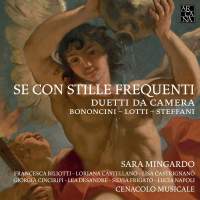Texte paru dans: / Appeared in: |
|
|
Outil de traduction ~ (Très approximatif) |
|
|
Reviewer: Barry
Brenesal
From the start, shortly before the turn of the 17th century, opera was considered, rightly, as a budget-breaking proposition. Whether funded through princely private income or massive public ticket sales or some combination of both, all aspects of opera contributed to it quickly becoming a money sink. And while chamber opera was an effective compromise for private audiences of the wealthy, a more informal way to enjoy at least some measure of opera’s theatrics came in the form of chamber cantatas and duets. (The latter in context is effectively a subcategory of the former.) Two singers and a few instrumentalists could perform a program of these small works, interspersed with instrumental works for soloists and ensembles. Throw in a break for a pleasant dinner with a couple of bottles of good wine, add other intermissions for discussion, numerous hors d’oeuvres, a garden walk, and some decent brandies, and you and your guests could enjoy a more casual, flexible entertainment through the evening and into the candlelit hours before dawn without the trappings of state. The chamber cantata became a very popular genre at various Italian and French courts during the latter part of the 17th and early 18th centuries, though its survival until very recent times only took the form of Handel’s more elaborate works for the likes of Marchese Francesco Ruspoli and Cardinal Pietro Ottoboni. Lately, however, interest has awakened in the cantatas of other Italian and French composers of the Baroque, including those featured on this disc.
Steffani’s three musically
conservative duets (he wrote over 70, which circulated widely in manuscript
and print) look back to the musical language and structures of Cavalli. They
are fairly simple but memorable examples of the genre, distinctive in their
materials and treatment, with movements that are in effect sections of a
larger single-movement structure. Lotti’s pair of duets are most notable for
their startling madrigalisms that employ dissonance and passages of
non-functional harmonies. (The opening movement of Se con stille frequenti
shifts harmonies suddenly on the word “accende” (ignites), as do, each in
their own way, the elaborate figurations in the final movement on the words
“lagrimar” and “fiamma” (tears and flame). At the other end of the
structural scale are Bononcini’s pair of duets, in which dialogues of
opposition are offered instead of voices attractively stating pretty much
the same thing. We’re still nowhere near the complexities and characterful
arguments of Handel’s Il trionfo del tempo e del disinganno, for one, but
then these works shouldn’t be viewed as part of an evolution towards
anything. Each is enjoyable in its own right.
The outlier on this disc is an
aria by Francesco Lucio (1628–1658), drawn from his opera L’Euridamante. It
is anachronistically edited—for one thing, the harpsichord isn’t featured as
a solo instrument in Italian Baroque cantatas, yet it is here. Presumably
this and other changes were approved to create a certifiable album hit,
since the work duplicates several aspects of the famed central section of
Monteverdi’s Lamento della ninfa (most generally and obviously, a descending
figure in a minor-key ostinato) without its musical framing device of the
shepherd’s Greek chorus that confuses some modern listeners. It also points up one of the oddities of this album’s casting. Sara Mingardo is given top billing in a much larger font than the other seven singers, but she only appears in three of the duets (never as a soloist in individual sections, as all but one of the other singers are), plus the aria. If you’re a fan of the contralto, you may want to keep in mind that most of this album displays the work of other musicians. Fortunately, the singing is, for the most part, consistently strong, some reservations about squeezed tone and sketchy coloratura in Chi d’Amor tra le catene to one side. Each singer possesses formidable agility, a wide range, good enunciation and a sense of style. I would single out mezzo Lea Desandre for her finely controlled flicker vibrato and bright top, and soprano Silvia Frigato for her coloring phrases in her midrange through nuanced application of the chest voice. The accompaniment is supplied by four-person Cenacolo Musicale, who provide plucked and bowed strings as well as keyboards. All in all, this is an attractive album of Italian Baroque duets, from three composers with distinctive musical styles, all well worth hearing. In excellent sound, with fine performances, it is well worth a recommendation. | |
|
Support us financially by purchasing this disc from eiher one of these suppliers. Un achat via l'un ou l'autre des fournisseurs proposés contribue à défrayer les coûts d'exploitation de ce site. |
|
|
|
|
|
Cliquez l'un ou l'autre
bouton pour découvrir bien d'autres critiques de CD |
|




